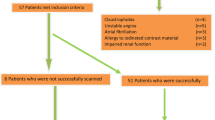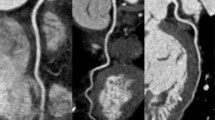Abstract
To determine the feasibility of dual-source coronary CT angiography (CTA) using a prospectively electrocardiogram (ECG)-triggered axial mode to target end-systole in patients with high heart rates (HR) as compared with the retrospective mode. One hundred fifty consecutive patients with regular HR > 75 bpm who underwent coronary CTA were enrolled; 75 patients underwent prospectively ECG-triggered coronary CTA targeting only end-systole (Prospective Axial Group) and 75 patients underwent retrospectively ECG-gated coronary CTA (Retrospective Helical Group). The image quality of multiple coronary artery segments was evaluated and radiation doses were recorded. The diagnostic performance of coronary CTA was compared to the reference standard of invasive coronary angiography in 52 patients (35 %) (28 patients in Prospective Axial Group and 24 patients in Retrospective Helical Group). Image quality was not significantly different between the 2 groups (P = 0.784). In subgroup analysis, segment-based sensitivity, specificity, and positive and negative predictive values of coronary CTA were 98, 96, 88 and 99 %, respectively, in the Prospective Axial Group and were 97, 95, 82, and 99 %, respectively, in the Retrospective Helical Group. Mean radiation dose was significantly lower for the Prospective Axial Group than for the Retrospective Helical Group (2.9 ± 1.4 vs. 7.4 ± 3.3 mSv; P < 0.0001). Dual source coronary CTA with a prospective ECG-triggered axial mode targeting end-systole is feasible in patients with regular high HRs for evaluation of coronary artery disease. It provides comparable image quality and diagnostic value with substantially lower radiation exposure as compared to the retrospective ECG–gated helical technique.




Similar content being viewed by others
References
von Ballmoos MW, Haring B, Juillerat P, Alkadhi H (2011) Meta-analysis: diagnostic performance of low-radiation-dose coronary computed tomography angiography. Ann Intern Med 154(6):413–420. doi:10.1059/0003-4819-154-6-201103150-00007
Sun Z, Lin C, Davidson R, Dong C, Liao Y (2008) Diagnostic value of 64-slice CT angiography in coronary artery disease: a systematic review. Eur J Radiol 67(1):78–84. doi:10.1016/j.ejrad.2007.07.014
Alkadhi H, Leschka S (2011) Radiation dose of cardiac computed tomography––what has been achieved and what needs to be done. Eur Radiol 21(3):505–509. doi:10.1007/s00330-010-1984-3
Earls JP, Leipsic J (2010) Cardiac computed tomography technology and dose-reduction strategies. Radiol Clin North Am 48(4):657–674. doi:10.1016/j.rcl.2010.04.003
Sun Z, Ng KH (2012) Prospective versus retrospective ECG-gated multislice CT coronary angiography: a systematic review of radiation dose and diagnostic accuracy. Eur J Radiol 81(2):e94–100. doi:10.1016/j.ejrad.2011.01.070
Shuman WP, Branch KR, May JM, Mitsumori LM, Lockhart DW, Dubinsky TJ, Warren BH, Caldwell JH (2008) Prospective versus retrospective ECG gating for 64-detector CT of the coronary arteries: comparison of image quality and patient radiation dose. Radiology 248(2):431–437. doi:10.1148/radiol.2482072192
Abbara S, Arbab-Zadeh A, Callister TQ, Desai MY, Mamuya W, Thomson L, Weigold WG (2009) SCCT guidelines for performance of coronary computed tomographic angiography: a report of the society of cardiovascular computed tomography guidelines committee. J Cardiovasc Comput Tomogr 3(3):190–204. doi:10.1016/j.jcct.2009.03.004
Blanke P, Baumann T, Bulla S, Schaefer O, Kotter E, Langer M, Pache G (2010) Prospective ECG-triggered CT angiography of the thoracic aorta in patients with atrial fibrillation or accelerated heart rates: feasibility and image quality. Am J Roentgenol 194(1):W111–114. doi:10.2214/AJR.09.3153
Hou Y, Yue Y, Guo W, Feng G, Yu T, Li G, Vembar M, Olszewski ME, Guo Q (2012) Prospectively versus retrospectively ECG-gated 256-slice coronary CT angiography: image quality and radiation dose over expanded heart rates. Int J Cardiovasc Imaging 28(1):153–162. doi:10.1007/s10554-010-9760-7
Xu L, Yang L, Zhang Z, Li Y, Fan Z, Ma X, Lv B, Yu W (2010) Low-dose adaptive sequential scan for dual-source CT coronary angiography in patients with high heart rate: comparison with retrospective ECG gating. Eur J Radiol 76(2):183–187. doi:10.1016/j.ejrad.2009.06.003
Austen WG, Edwards JE, Frye RL, Gensini GG, Gott VL, Griffith LS, McGoon DC, Murphy ML, Roe BB (1975) A reporting system on patients evaluated for coronary artery disease. Report of the Ad Hoc Committee for Grading of Coronary Artery Disease, Council on Cardiovascular Surgery, American Heart Association. Circulation 51(4 Suppl):5–40
Matt D, Scheffel H, Leschka S, Flohr TG, Marincek B, Kaufmann PA, Alkadhi H (2007) Dual-source CT coronary angiography: image quality, mean heart rate, and heart rate variability. AJR Am J Roentgenol 189(3):567–573. doi:10.2214/AJR.07.2078
Goo HW (2012) CT radiation dose optimization and estimation: an update for radiologists. Korean J Radiol 13(1):1–11. doi:10.3348/kjr.2012.13.1.1
Brodoefel H, Burgstahler C, Tsiflikas I, Reimann A, Schroeder S, Claussen CD, Heuschmid M, Kopp AF (2008) Dual-source CT: effect of heart rate, heart rate variability, and calcification on image quality and diagnostic accuracy. Radiology 247(2):346–355. doi:10.1148/radiol.2472070906
Feng Q, Yin Y, Hua X, Zhu R, Hua J, Xu J (2010) Prospective ECG triggering versus low-dose retrospective ECG-gated 128-channel CT coronary angiography: comparison of image quality and radiation dose. Clin Radiol 65(10):809–814. doi:10.1016/j.crad.2010.05.005
Conflict of interest
None.
Author information
Authors and Affiliations
Corresponding author
Rights and permissions
About this article
Cite this article
Kim, H.Y., Lee, J.W., Hong, Y.J. et al. Dual-source coronary CT angiography in patients with high heart rates using a prospectively ECG-triggered axial mode at end-systole. Int J Cardiovasc Imaging 28 (Suppl 2), 101–107 (2012). https://doi.org/10.1007/s10554-012-0142-1
Received:
Accepted:
Published:
Issue Date:
DOI: https://doi.org/10.1007/s10554-012-0142-1




